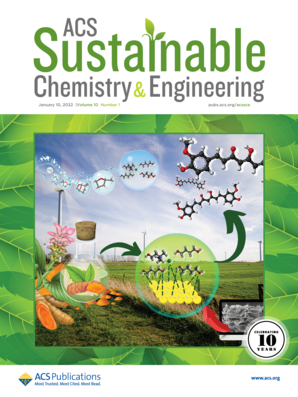机械化学与高级氧化和螯合耦合用于废旧锂离子电池的可持续回收
IF 7.1
1区 化学
Q1 CHEMISTRY, MULTIDISCIPLINARY
引用次数: 0
摘要
废旧锂离子电池的激增带来了巨大的环境风险,但传统的回收方法存在高能耗、设备腐蚀和二次污染等问题。在这里,我们开发了一种可持续的方法,将机械化学与高级氧化结合起来,从废三元锂离子电池中回收有价值的金属。在优化条件下,Li、Ni、Co和Mn的浸出效率分别为98.89%、98.90%、97.42%和98.99%。自由基捕获实验表明,机械化学过程激活过硫酸铵,产生羟基和硫酸盐自由基,通过选择性自由基淬火实验进一步证实了这一点。x射线衍射分析表明,这些自由基的协同作用导致正极材料层状结构的坍塌。x射线光电子能谱分析表明,柠檬酸有助于将高价金属离子还原为可溶态,同时保持有利于金属浸出的酸性环境。这种创新的方法通过采用湿球磨工艺消除了传统的分离浸出步骤,其中柠檬酸同时螯合和还原金属离子,从而产生明显均匀的前驱体,直接提高了最终的煅烧产物。再生的三元正极材料具有优异的电化学性能,放电容量为125 mAh·g-1,循环100次后容量保持率为94.64%。生命周期评估表明,与传统的湿法冶金工艺相比,该工艺对环境的影响显著降低。该研究为自由基在固相机械化学系统中的作用提供了新的见解,并为电池回收建立了可持续的策略。本文章由计算机程序翻译,如有差异,请以英文原文为准。

Coupling Mechanochemistry with Advanced Oxidation and Chelation for Sustainable Recovery of Spent Ternary Lithium-Ion Batteries
The surge in spent lithium-ion batteries poses significant environmental risks, yet conventional recycling methods suffer from high energy consumption, equipment corrosion, and secondary pollution. Here, we develop a sustainable approach integrating mechanochemistry with advanced oxidation for recovering valuable metals from spent ternary lithium-ion batteries. Under optimized conditions, exceptional leaching efficiencies of 98.89%, 98.90%, 97.42%, and 98.99% were achieved for Li, Ni, Co, and Mn, respectively. The free radical capture experiments demonstrated that the mechanochemical process activates ammonium persulfate, generating hydroxyl and sulfate radicals, which was further confirmed through selective radical quenching experiments. The synergistic effect of these radicals induces the collapse of the layered structure of cathode material, as evidenced by X-ray diffraction analysis. X-ray photoelectron spectroscopy demonstrated that citric acid facilitates the reduction of high-valence metal ions to their soluble states while maintaining an acidic environment conducive to metal leaching. This innovative approach eliminates the conventional separate leaching step by employing a wet ball-milling process where citric acid simultaneously chelates and reduces metal ions, resulting in a significantly homogeneous precursor that directly enhances the final calcination product. The regenerated ternary cathode material exhibited excellent electrochemical performance with a discharge capacity of 125 mAh·g–1 and 94.64% capacity retention after 100 cycles. Life cycle assessment indicated significantly reduced environmental impact compared to traditional hydrometallurgical processes. This study provides new insights into the mechanistic role of free radicals in solid-phase mechanochemical systems and establishes a sustainable strategy for battery recycling.
求助全文
通过发布文献求助,成功后即可免费获取论文全文。
去求助
来源期刊

ACS Sustainable Chemistry & Engineering
CHEMISTRY, MULTIDISCIPLINARY-ENGINEERING, CHEMICAL
CiteScore
13.80
自引率
4.80%
发文量
1470
审稿时长
1.7 months
期刊介绍:
ACS Sustainable Chemistry & Engineering is a prestigious weekly peer-reviewed scientific journal published by the American Chemical Society. Dedicated to advancing the principles of green chemistry and green engineering, it covers a wide array of research topics including green chemistry, green engineering, biomass, alternative energy, and life cycle assessment.
The journal welcomes submissions in various formats, including Letters, Articles, Features, and Perspectives (Reviews), that address the challenges of sustainability in the chemical enterprise and contribute to the advancement of sustainable practices. Join us in shaping the future of sustainable chemistry and engineering.
 求助内容:
求助内容: 应助结果提醒方式:
应助结果提醒方式:


